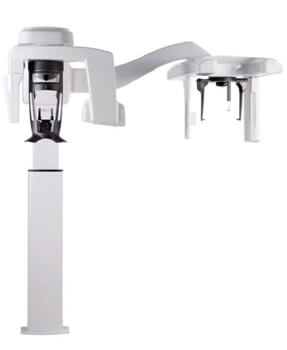CBCT Technology In South Side
CBCT (Cone Beam Computed Tomography) technology is a medical imaging technique that utilizes a cone-shaped X-ray beam, a two-dimensional detector, a rotating gantry, and advanced software algorithms to generate detailed 3D images of a patient’s internal structures through reconstruction.

CBCT Technology
What Is CBCT?
Cone Beam Computed Tomography (CBCT) is a specialized medical imaging technique that generates three-dimensional images of internal structures within the body. It shares similarities with traditional computed tomography (CT) imaging, but CBCT employs a cone-shaped X-ray beam to capture more detailed images while minimizing radiation exposure. In dentistry, CBCT technology plays a crucial role in the diagnosis, treatment planning, and surgical guidance processes.
By utilizing a cone-shaped beam, CBCT ensures precise radiation targeting to the specific area of interest, thereby reducing the risks of side effects and exposure to surrounding tissues. The resulting CBCT images provide detailed anatomical information, enabling accurate surgical planning and guidance.
CBCT technology holds immense significance in dentistry for the diagnosis and treatment of various conditions such as tooth decay, jaw disorders, and dental implants. The precise 3D images it produces of the teeth, jaws, and surrounding structures empower dentists to plan and execute complex dental procedures, including orthodontic surgery, root canal treatments, and dental implant placements. Overall, CBCT has revolutionized dental care, offering patients more accurate and effective treatment options while minimizing both risk and discomfort.
How Has CBCT ‘Revolutionized’ Dental Imaging?
The advent of CBCT technology has sparked a revolutionary transformation in the realm of dental imaging. With its advanced capabilities, it enables the generation of high-resolution 3D images showcasing the teeth, jawbones, and surrounding structures. These intricate images provide dental professionals with the necessary precision to accurately diagnose and treat a wide range of dental conditions, from tooth decay to complex surgical procedures.
In contrast to traditional X-rays, which often require multiple images to capture different angles of the mouth, CBCT technology significantly reduces radiation exposure for patients. This reduction in radiation-related risks has made the procedure safer and more secure for patients.
Furthermore, the precise images produced by CBCT technology have led to less invasive dental treatments, resulting in shorter recovery times and reduced discomfort for patients.
Say goodbye to traditional X-rays and embrace the groundbreaking high-resolution 3D images offered by CBCT in dental imaging!
CBCT Benefits
Accurate Diagnosis
By utilizing CBCT technology, dental professionals can acquire high-resolution 3D images of teeth, jawbones, and surrounding structures, thereby significantly improving the accuracy of dental condition diagnoses in comparison to traditional X-rays.
Minimized Radiation Exposure
Unlike traditional X-rays, CBCT technology reduces radiation exposure for patients, thereby lowering the risk of radiation-related side effects and enhancing overall safety during the procedure.
Precise Treatment Planning
With the utilization of the detailed and precise images generated by CBCT, dental professionals can meticulously plan and execute intricate dental procedures, such as dental implant placement, with heightened accuracy and precision.
Less Invasive Procedures
The incorporation of CBCT technology has streamlined dental treatments, resulting in less invasive procedures that lead to shorter recovery times and decreased discomfort for patients. Furthermore, CBCT has greatly improved the overall dental experience, ensuring increased comfort and a stress-free environment for patients.



